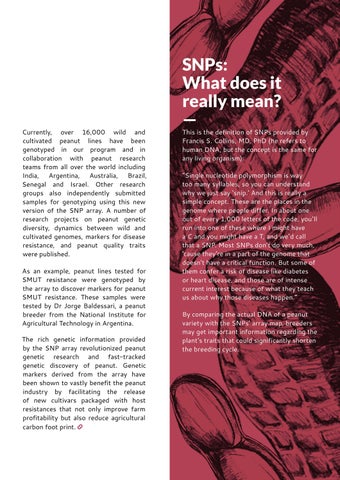Currently, over 16,000 wild and cultivated peanut lines have been genotyped in our program and in collaboration with peanut research teams from all over the world including India, Argentina, Australia, Brazil, Senegal and Israel. Other research groups also independently submitted samples for genotyping using this new version of the SNP array. A number of research projects on peanut genetic diversity, dynamics between wild and cultivated genomes, markers for disease resistance, and peanut quality traits were published. As an example, peanut lines tested for SMUT resistance were genotyped by the array to discover markers for peanut SMUT resistance. These samples were tested by Dr Jorge Baldessari, a peanut breeder from the National Institute for Agricultural Technology in Argentina. The rich genetic information provided by the SNP array revolutionized peanut genetic research and fast-tracked genetic discovery of peanut. Genetic markers derived from the array have been shown to vastly benefit the peanut industry by facilitating the release of new cultivars packaged with host resistances that not only improve farm profitability but also reduce agricultural carbon foot print.
SNPs: What does it really mean? —
This is the definition of SNPs provided by Francis S. Collins, MD, PhD (he refers to human DNA, but the concept is the same for any living organism): “Single nucleotide polymorphism is way too many syllables, so you can understand why we just say ‘snip.’ And this is really a simple concept. These are the places in the genome where people differ. In about one out of every 1,000 letters of the code, you’ll run into one of these where I might have a C and you might have a T, and we’d call that a SNP. Most SNPs don’t do very much, ’cause they’re in a part of the genome that doesn't have a critical function. But some of them confer a risk of disease like diabetes or heart disease, and those are of intense current interest because of what they teach us about why those diseases happen.” By comparing the actual DNA of a peanut variety with the SNPs’ array map, breeders may get important information regarding the plant’s traits that could significantly shorten the breeding cycle.




